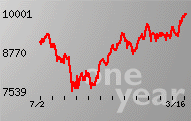|
Can Dow go distance on 10k?
|
 |
March 16, 1999: 5:04 p.m. ET
Milestone highs have often been followed by painful lows in the past
|
NEW YORK (CNNfn) - The flip side of euphoria over the Dow Jones industrial average chalking up another 1,000 points is that it has almost inevitably been followed by lows afterward.
However, while history indicates that the next step for the Dow after hitting 10,000 would be a slide downward, there is not universal agreement that it's inevitable this time around.
The Dow's travails on Tuesday were a microcosm of what often happens to the Dow when it hits its heights. After rising briefly over 10,000 early in the morning, it began dropping, ultimately ending the day lower than it started.
During the most recent Dow milestones, as when it crossed above 7,000, 8,000 and 9,000 it managed to climb about 1-4 percent higher but after peaking, fell between 10 and 20 percent.

Last year the Dow hit the 9,000 mark and declined for months afterward (active chart)
One of the most striking examples of the Dow's "fear of heights" occurred on November 14, 1972, when the blue chip index hit the 1,000 mark for the first time.
In the following days, it rose another 5 percent, then went down for about 2 years. It didn't reach the 1,100 mark until 1983, just over 10 years later.
Few people expect that kind of slump for the Dow now that it has crossed 10,000, but there is sentiment that this strong showing is fleeting.
"I think from here up until about the mid part of April we're probably going to see 10,500 or 10,400 on the Dow," said Peter Cardillo, stock analyst at Westfalia Investments.
"After that I'm looking for a correction of about 12 to 15 percent."
Cardillo based his assessment on the fact that during the first few months of the year, pension funds -- a large institutional investment sector -- typically invest less in the market.

Also adding to the cynical mix are high stock valuations, especially in the technology sector, which investors like Dave Brady, a mutual fund manager at Stein Roe Funds, feel defy fundamentals.
"I think the valuation models have been put in the closet about nine months ago and are collecting a lot of dust," said Brady.
That's not to say optimism about further strength for the Dow is non-existent.
There has been some hand-wringing on Wall Street because the market's run-up has been led by a very narrow band of stocks, mostly in the large cap arena.
While that may make the Dow's surge seem like a tenuous one at best, the flip side, say some Wall Street pros, is there's plenty of room for it to widen out. And investors won't always ignore the stocks on the sidelines.
"I guess the catalyst (for) the small and mid-cap stocks, which are really the sectors that have been left behind, will be earnings growth," said Brady.
"You're not going to have companies that are growing at 30 percent selling at 10 times earnings for long."
Also underpinning a continued Dow climb is the general economic climate. Recent data seems to indicate that inflationary pressures are low in the U.S. economy.
Even Federal Reserve Chairman Alan Greenspan agrees. And when he voices those opinions, Wall Street worries less about a rise in interest rates and continues to plow its money into the stock market.
Still, focusing on the Dow's fate too much could be a mistake. Keith Mullins, a growth stock strategist at Salomon Smith Barney said the current climate could be good for investors looking to trade up.
"Periods like this with volatility allow you to upgrade the quality of your holdings," said Mullins.
He advised looking at your portfolio to find stocks which may have not done as well as you had hoped and getting rid of them, since they will probably do worse under volatility.
Instead, he said you may want to spend a little extra for stocks in the same sectors which have better fundamentals and can ride out any fluctuations better. Since many stocks could be struggling, even some of the better performers may be on sale.
"I think you can find the higher quality stocks get you the best return," he said. 
-- by staff writer Randall J. Schultz
|
|
|
|
|
 |

|

